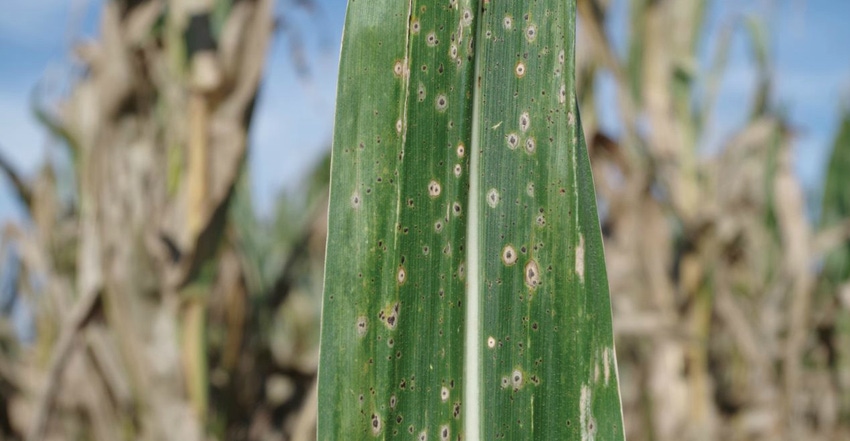July 1, 2019

Tar spot is a fungus disease of corn that first showed up in the U.S. in 2015. Symptoms of tar spot are small, raised irregular-shaped black lesions scattered across the surface of the corn leaf. It spreads from the lowest leaves to the upper leaves, and eventually appears on the husks of developing ears.
In 2018, tar spot was detected in 12 counties in eastern Iowa. The disease was observed late in the growing season, and it did not cause a lot of damage. In Wisconsin, Illinois, Michigan and Indiana, however, the disease was observed earlier — during grain fill stage — and caused significant yield loss. Tar spot reduced yields by 30 to 40 bushels per acre in some of those fields.
New tool being tested
Damon Smith, a corn disease researcher at the University of Wisconsin has developed a tar spot prediction model, called Tarspotter. It is being evaluated during the 2019 growing season by university Extension and industry colleagues throughout the Midwest. Iowa State University Extension plant pathologists are involved in helping evaluate Tarspotter.
You can go online and use Tarspotter to see what the calculated risk is for tar spot disease to show up this year in your area. The risk of this disease showing up in a few eastern Iowa locations this year was predicted by Tarspotter as of June 23.
“We have fungicide trials at the ISU Northeast Research Farm (NERF), near Nashua in northeast Iowa and at the ISU Southeast Research Farm (SERF), near Crawfordsville in southeast Iowa,” says Alison Robertson, ISU Extension plant pathologist. “Both of these research farms do not have a history of tar spot. However, the Waterloo, Dubuque and Davenport locations are situated in counties where tar spot was observed in 2018.��”
Don’t spray if you don’t have disease
The Tarspotter prediction model shows that the present risk for tar spot showing up in northeast Iowa this summer is high. Does that mean you should spray a fungicide now on your corn if you are located in northeast or eastern Iowa?
“No,” Robertson says. “Tar spot is yet to be observed in 2019 in Iowa, and even farther east in Wisconsin, Illinois, Michigan and Indiana, it hasn’t shown up yet this summer. That is the case, even though the weather has been conducive. This disease likes wet weather and moderate temperatures. You should carefully scout cornfields that have a history of tar spot. Scout the corn at growth stage V6 or older. A fungicide application is only needed if the disease is observed.”
If you observe tar spot, contact Robertson or the ISU Extension crop specialist for your area of the state. “We would like to collect data from the field to contribute to Dr. Smith's validation of Tarspotter,” she says.
About the Author(s)
You May Also Like






